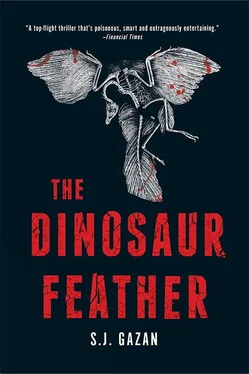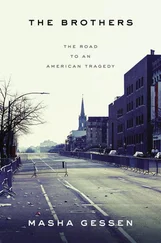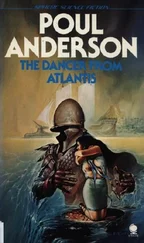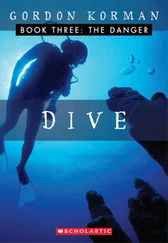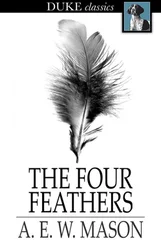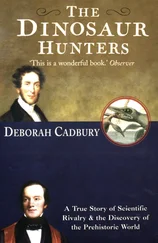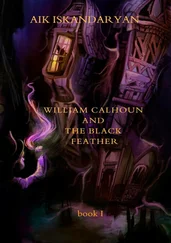Anna understood entirely why the new concept of evolution seemed unimaginable. For centuries the broad consensus had been that God had personally created every animal and plant and that the mouse and the cat, the beech and the maple were no more related than the desert and the firmament or the sun and the dew on the grass. Everything was God’s work and one creature couldn’t simply evolve into another, nor could animals and plants become extinct unless it was God’s wish to remove the species in question from production. As far as birds were concerned, it therefore didn’t follow that the sparrow was related to the starling, the flamingo, the shearwater, or any other bird, or that birds as a group were related to each other or to dinosaurs or reptiles or any other animal. They had been put on Earth, aerodynamic and fully developed, by God. Voilà .
The theory of evolution broke completely with the doctrine that the Earth and all its organisms had been created by one divine being, and this was a huge challenge: how could people suddenly accept that evolution happened by itself, without God’s influence, just like that?
The dream continued. The sun was now high above Solnhofen. After a quick consultation about today’s tasks and a cup of coffee as black as tar, they all got to work. Anna’s area was a gentle slope behind the rest of the team, and she had only to raise her head to see where the others were and what they were doing. The lithographic limestone slab spread out beneath her like a huge blackboard. She scraped, eased away a couple of layers, brushed sand and soil aside, coaxed the earth; she took off her jacket and pushed up her sleeves. An isolated gust of wind from the south forced her to close her eyes to avoid the dust. When she opened them again and looked down, she saw the fossil. The wind had removed nearly all the excess material, and though another two layers needed to be removed before the creature would lie fully revealed, there was no mistaking it. Beneath her, bathed in the light from a yellow sun, lay Archaeopteryx Lithographica , one of the world’s most precious fossils. It was slightly smaller than a present-day hen and had one wing beautifully unfurled. In this respect the dream was a bit of a cheat, she thought, because she instantly knew what she had discovered. She recognized the small bird from hundreds of photos; only two weeks ago, in the vertebrate collection at the Natural History Museum, she had been studying the impression—which the Germans had reluctantly allowed a Danish paleontologist to make—of the Berlin Specimen, as Archaeopteryx Lithographica was known. She recognized the flight feathers, which lay like perfectly unfurled lamella against the dark background, she saw the relatively large tail feather, the wondrously faultless location of the rear and front limbs and the arched position of its flawlessly formed skull, which made this specimen superior to anything else discovered so far. In 1861, the newly discovered London Specimen had been sold to the British Natural History Museum for £700. Now Anna had uncovered one of the ten most beautiful and significant fossils in the world: the Berlin Specimen.
Her instinctive reaction was to punch the air and cry out in triumph to von Molsen, who was standing some distance away in deep thought, holding his pipe, but what she needed now was a plan. Anna had to beckon von Molsen in a manner that made it clear she had stumbled across something extraordinary, while simultaneously sounding sufficiently vague in her conclusion so von Molsen wouldn’t get the impression that she already knew what she had found. That would surely make him suspicious.
Von Molsen turned around instantly when she called him and came toward her with reverence. When he reached her, he knelt down by the excavation and stared for a long time at the fossilized animal that was emerging. Carefully, he worked on the last two layers of the limestone sediment, whereupon, with great awe, he traced the perfect body of the small bird with his finger. Anna knew that the bird was 150 million years old.
“Well done, my girl,” he said. When he turned to look at her, she noticed that one of his eyes was almost purple. Her find had shaken him to his core.
“Mom?”
Von Molsen laid his pipe on the ground, took out his magnifying glass and, right at this point when Anna absolutely didn’t want the dream to end, it started to dissolve.
“Mom, I want to get into your bed,” a little voice pleaded. Anna clenched her fists and woke up in Copenhagen.
The light in her bedroom was dim. Lily was standing next to the bed, in her onesie, with a soaked diaper, which Anna Bella grabbed hold of as she swung the child into her bed. Lily snuggled up to her. It wasn’t even six o’clock yet. Pale, white dawn light was starting to creep in, but it would be another half hour, at least, before any objects would be visible. Her sheets were freshly washed and felt crisp.
A figure was standing between the window and the door to the living room. It was Friedemann von Molsen. She couldn’t see his face, but she recognized the broad-brimmed felt hat he wore against the merciless sun. Anna’s heart pounded inside her ribcage. She wanted him to disappear. Von Molsen watched her silently, just as lifelike as he had been in her dream.
“If I wait long enough,” she told herself, “the light will make him go away.”
She knew she must be imagining this. She had to be. And yet she saw him just as clearly in the gray dawn as she saw the tall dresser next to the door, the green vase on top of it, and the silhouette from the lilies she had bought yesterday and put in the vase.
Later, when she looked back at this morning, she knew exactly what von Molsen was.
He was an omen.
Monday morning, October 8. The Institute of Biology was an H-shaped building squeezed in between the Natural History Museum and the August Krogh Institute in the University Park in the Østerbro area of Copenhagen. The main building was a narrow rectangle of four floors, which bordered Jagtvejen on one side and a cobbled square on the other.
Anna Bella parked her bicycle outside the entrance to Building 12, which housed the department of Cell Biology and Comparative Zoology on its second floor. It had been a terrible morning. When she tried to drop off Lily at nursery, Lily had sobbed and refused to let go of her in the coat room. Through the window in the door Anna could see the other toddlers, see them fetch their cushions and get ready for morning assembly. Lily was inconsolable. She clung to her mother, smearing snot and tears into Anna’s jacket.
Eventually, one of the nursery teachers came to Anna’s rescue. Lily’s sobbing grew louder. Desperation gushed from the pores of Anna’s skin. She looked at the nursery teacher with pleading eyes and the nursery teacher lifted Lily up, so they could pull the snowsuit off her.
Anna suffered from a permanently guilty conscience. Cecilie, Anna’s mother, looked after Lily almost all the time. Cecilie had volunteered her help six months earlier when Anna’s studies had become increasingly demanding.
“If you’re to have any hope of finishing your dissertation within the allotted time, you can’t possibly leave the university at four o’clock every day to pick up Lily from nursery,” she had argued.
And that had been that. Lily loved her granny, Anna told herself, so why not? It was the obvious solution.
For several months she had worked virtually around the clock, and although she had finally submitted her dissertation, she still had to prepare for her forthcoming thesis defense. No matter how much Anna missed her daughter and knew very well that the temporary arrangement had gotten out of hand, there simply was no room for Lily in the equation. And, as she kept telling herself: Lily liked being with Granny.
Читать дальше
